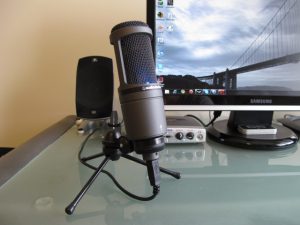 Walk into any top-end recording studio ask to look inside their microphone cabinet. Without many exceptions you’ll stumble upon an Audio-Technica AT4050 condenser mic. It has become an industry standard due to its virtues as a versatile, “workhorse” microphone.
Walk into any top-end recording studio ask to look inside their microphone cabinet. Without many exceptions you’ll stumble upon an Audio-Technica AT4050 condenser mic. It has become an industry standard due to its virtues as a versatile, “workhorse” microphone.
As great as the AT4050 is, the price tag of around $600 puts it out of reach for most hobbyists. Although Audio-Technica is known for professional products they have come up with the AT2020 to meet the needs of podcasters and DIY recording musicians. In stark contrast to the 4050, the 2020 sells for $115 (street price). On top of that, you don’t need a fancy preamp, and audio interface to make USB mics sound good.
At this price you come to expect a plasticky feel or cheap, roughly finished aluminum. Upon pulling it out of the box the most striking property of this mic is the outstanding build quality. I’m one of the old fashion types that associates weight with well-made gear; the 2020 has just the right amount of weight to make me feel confident in its durability.
The AT2020 design is very utilitarian and similar to its big brothers like the AT4050. It is a simple cylinder shape with a grill so big that it spans half the length of the microphone. The USB cable plugs into the bottom just like traditional XLR mics. It draws its power from the USB port on your computer. To notify you that it’s powered up, the grill lights up blue thanks to an internal LED light.
AT has taken a very different approach than Blue Microphones has. The Blue Yeti and Snowball has a switch that allows you to change up the input pattern of the mic. The 2020 focuses on the most used pattern: cardioid. Although you’ll use the cardioid pattern the vast majority of the time as a podcaster or musician, omnidirectional recording is missed because it is fun to experiment with.
On the plus side, the knobs and switches feel a little flimsy on the Blue USB mics. Clearly this is because USB microphones are sold for so little, making cost-cutting an inevitable reality. Audio-Technica’s decision to make the unit rock-solid, and leave out controls that can just as easily be controlled from your laptop was a smart one.
Bit depth and sample rate meet the standard for current-gen USB mics: 16 bit/44.1 kHz. Frequencies between 20Hz and 16kHz are captured. This was a disappointment initially because Blue’s Yeti has a frequency range of 20Hz to 20kHz. Granted, we are looking at a range of sound that most adults cannot hear after the age of 30. If voice or vocal recording is your goal, don’t sweat it. Only cymbals have frequencies of any magnitude that go past 16kHz.
Sound quality is very good as is expected from an Audio-Technica product. Tests with acoustic guitar and vocals yielded impressive results. The capsule is sensitive, perhaps too much so for the casual user. You’ll pick up a decent bit of background noise if you have a desktop computer running nearby. Either run a cable into a different room or invest in a shock-mount to avoid picking up noise.
Review Verdict
Audio-Technica’s AT2020 doesn’t have any gimmicks to speak of. It does a good job of capturing voices or instruments coming from in front of the mic. After all, that is all most people will ever need. On-location interviewers and experimental musicians will yearn for the variety of input patterns found in competing mics.
This is an awesomely built device making it the most road-worthy USB microphone tested thus far. Overall the 2020 is simple, strong and effective at recording 16-bit audio.

